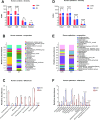Ruminal microbiota-host crosstalks promote ruminal epithelial development in neonatal lambs with alfalfa hay introduction
- PMID: 38179946
- PMCID: PMC10878101
- DOI: 10.1128/msystems.01034-23
Ruminal microbiota-host crosstalks promote ruminal epithelial development in neonatal lambs with alfalfa hay introduction
Abstract
Ruminal microbiota is gradually established after birth, while microbiota maturation could be highly diverse because of varied solid dietary accessibility. However, how the ruminal microbiota accreted from postnatal hay diets alters rumen epithelial development, and how this affects animal health remains largely unknown. Here, neonatal lambs were introduced to starchy corn-soybean starter or corn-soybean starter + alfalfa hay (AH) to investigate the influences of early life ruminal microbiome on rumen epithelial development using integrated 16s rRNA sequencing-metagenome-transcriptome approaches. The results showed that AH introduction elevated average daily weight gain, rumen weight and volume, rumen epithelial papillae length, and rumen muscle layer thickness. Meanwhile, the relative abundance of fibrolytic bacteria (Christensenellaceae R-7 group, Prevotellaceae UCG-001, and Succinivibrio), acetate producer (Acetitomaculum and Mitsuokella), and propionate producer Succiniclasticum was increased in the rumen content by AH supplementation (P < 0.05). Moreover, AH introduction decreased the relative abundance of total CAZymes, CBM, and GH and increased the abundance of KO genes related to volatile fatty acid (VFA) generation in the rumen content. AH lambs had a higher relative abundance of Succiniclasticum, Megasphaera, Succinivibrio, and Suttonella (P < 0.05), while a lower relative abundance of Cloacibacillus, Desulfovibrio, Dialister, Intestinimonas, Parabacteroides, and Pseudoscardovia (P < 0.05) in the rumen epithelial samples. Furthermore, these alterations in ruminal microbial structure and function resulted in ruminal epithelial cell proliferation and development pathways activation. In summary, AH introduction benefited ruminal fiber degradation and VFA generation bacteria colonization and promoted ruminal epithelial development. These findings provide new insights into ruminal microbial-host interactions in the early life.IMPORTANCEWhile it is established that a fiber-rich diet promotes rumen development in lambs, further research is needed to investigate the precise response of rumen microbiota and epithelium to high-quality alfalfa hay. Here, we observed that the inclusion of alfalfa hay led to a discernible alteration in the developmental trajectory of the rumen. Notably, there was a favorable shift in the rumen's volume, morphology, and the development of rumen papillae. Furthermore, ruminal microbial structure and function resulted in ruminal epithelial cell proliferation and development pathways activation, collectively provide compelling evidence supporting the capacity of alfalfa hay to enhance rumen development and health through ruminal micrbiota-host crosstalks. Our findings elucidate the functional response of the rumen to alfalfa hay introduction, providing new insights into strategies for promoting healthy development of the rumen in young ruminants.
Keywords: alfalfa hay; epithelial function; microbial community; rumen development; sucking lambs.
Conflict of interest statement
The authors declare no conflict of interest.
Figures






Similar articles
-
Diet-ruminal microbiome-host crosstalk contributes to differential effects of calf starter and alfalfa hay on rumen epithelial development and pancreatic α-amylase activity in yak calves.J Dairy Sci. 2021 Apr;104(4):4326-4340. doi: 10.3168/jds.2020-18736. Epub 2021 Feb 13. J Dairy Sci. 2021. PMID: 33589262
-
Initial timing of alfalfa hay supplementation manipulates blood parameters, rumen gene expression, and epithelial microbiota in pre-weaning lambs.J Anim Sci. 2024 Jan 3;102:skae188. doi: 10.1093/jas/skae188. J Anim Sci. 2024. PMID: 39031018 Free PMC article.
-
Ruminal microbiome-host crosstalk stimulates the development of the ruminal epithelium in a lamb model.Microbiome. 2019 Jun 3;7(1):83. doi: 10.1186/s40168-019-0701-y. Microbiome. 2019. PMID: 31159860 Free PMC article.
-
Understanding the Diversity and Roles of the Ruminal Microbiome.J Microbiol. 2024 Mar;62(3):217-230. doi: 10.1007/s12275-024-00121-4. Epub 2024 Apr 25. J Microbiol. 2024. PMID: 38662310 Review.
-
Understanding the role of rumen epithelial host-microbe interactions in cattle feed efficiency.Anim Nutr. 2022 Apr 16;10:41-53. doi: 10.1016/j.aninu.2022.04.002. eCollection 2022 Sep. Anim Nutr. 2022. PMID: 35647325 Free PMC article. Review.
Cited by
-
Adaptive survival strategies of rumen microbiota with solid diet deficiency in early life cause epithelial mitochondrial dysfunction.ISME J. 2025 Jan 2;19(1):wraf064. doi: 10.1093/ismejo/wraf064. ISME J. 2025. PMID: 40188484 Free PMC article.
References
-
- Martinez-Alvaro M, Mattock J, Auffret M, Weng Z, Duthie C-A, Dewhurst RJ, Cleveland MA, Watson M, Roehe R. 2022. Correction: microbiome-driven breeding strategy potentially improves beef fatty acid profile benefiting human health and reduces methane emissions. Microbiome 10:166. doi:10.1186/s40168-022-01392-y - DOI - PMC - PubMed
MeSH terms
Substances
Grants and funding
LinkOut - more resources
Full Text Sources
Research Materials

